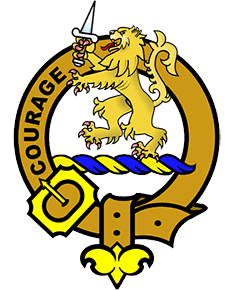Cumming Clan
Cumming Clan Crest: A Lion rampant with a dagger in it's paw.
Cumming Clan Motto: Courage.
Cumming/Comyn Clan History:
A once powerful family who originated from the town of Comines, near Lille, in France. In early records the surname appears with the prefix 'de,' and there is an apocryphal claim that the family descends from the Roman Emperor Charlemagne.
Robert de Comyn accompanied William the Conqueror to England in 1066, and was created Earl of Northumberland. On his return to Scotland from his brother-in-law's Court in England, David I invited Robert's grandson William, to accompany him and granted him lands in Berwickshire. Robert eventually became Chancellor of Scotland, and his nephew, Richard, married Hextilda, granddaughter of Donald Bane, second son of Duncan I, who later became briefly Donald III. By the reign of Alexander III, the de Comyns held four earldoms - Angus, Atholl, Menteith and Buchan.
Through marriage to the sister of John Balliol, and through his decent from King Duncan, John de Comyn, Lord of Badenoch, also had a strong claim to the Scottish throne. Among the Six Guardians of the Realm appointed when Alexander III died in 1286 were Alexander de Comyn, Earl of Buchan, and 'Black John' Comyn, Lord of Badenoch, and it was they, along with Robert Bruce, grandfather of the future King, who invited Edward I of England to mediate in the choice of Alexander's successor.
Edward I's choice was John Balliol, coupled with his insistence that he, himself, be recognised as 'Overlord of Scotland,' a demand which, at the time, the Guardians were in no position to refuse. With the failure of John Balliol to hold the country together, infighting began among the other claimants and, in 1306, aware of his cousin's treachery, Robert Bruce called a meeting with John 'The Red' Comyn in the Church of the Greyfriars in Dumfries. An argument ensued and Comyn was stabbed to death, an act for which Bruce was to be excommunicated by the Pope.
The final stages of Bruce's campaign, with the Red Comyn's son being killed fighting for the English at the Battle of Bannockburn, saw the collapse of Comyn power. However, there were many branches of the family in Scotland and from this point onwards the spelling of the name generally changed to Cumming, with the Cummings of Altyre, who descended from a brother of Donald Dubh, third son of the Red Comyn, being recognised as the Chiefly Line.
Sir Alexander Cumming of Altyre was created a baronet in 1804. Sir William Gordon Cumming, 4th Baronet, served with the Scots Guards, but became involved in a notorious gambling scandal which implicated the Prince of Wales.
Places of Interest:
Balvenie Castle, Dufftown, Speyside. Ruins of 14th century moated stronghold of Comyns situated on River Fiddich.
Deer Abbey, near Peterhead, Aberdeenshire. Founded in 1219 by William Comyn, Earl of Buchan for Cistercian Monks from Kinloss.
Inverlochy Castle, Fraserburgh, Aberdeenshire. Within the grounds of the famous hotel, is a 13th century castle built for the Comyns.
Lochindorb, Morayshire. An island fortress notorious for its association in the early 14th century with the Wolf of Badenoch, son of Robert II. It was, however, originally built by the Comyns.
House of Blair-Altyre, Morayshire. Seat of the Chief of Clan Cumming.
Cruggleton Castle, Garlieston, Galloway. Massive 13th century fortalice held by the Comyns, but little of it now remains.
Surname distribution in Scotland: The Cumming surname is most commonly found in Highland (includes the historic counties of Caithness, Inverness-shire, Nairnshire, Ross and Cromarty, Sutherland and small parts of Argyllshire and Morayshire), Moray (Elginshire), Aberdeenshire (includes part of Banffshire and all of Kincardinshire), Angus (Forfarshire) and Dundee City.
Associated family names (Septs): Buchan, Cheyne, Chene, Common, Commons, Comyn, Cummin, Cummings, Cumyn, Farquharson, MacNiven, Niven, Russell.
Buy a Clan Cumming membership certificate.

